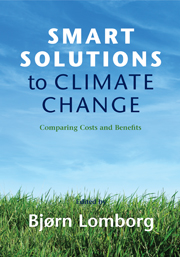Book contents
- Frontmatter
- Contents
- List of figures
- List of tables
- List of contributors
- Acknowledgments
- List of abbreviations and acronyms
- Introduction
- PART I THE SOLUTIONS
- 1 Climate Engineering
- 2 Carbon Dioxide Mitigation
- 3 Forestry Carbon Sequestration
- 4 Black Carbon Mitigation
- 5 Methane Mitigation
- 6 Market- and Policy-Driven Adaptation
- 7 Technology-Led Climate Policy
- 8 Technology Transfer
- PART II RANKING THE OPPORTUNITIES
- Conclusion
- Index
- References
1 - Climate Engineering
Published online by Cambridge University Press: 05 June 2012
- Frontmatter
- Contents
- List of figures
- List of tables
- List of contributors
- Acknowledgments
- List of abbreviations and acronyms
- Introduction
- PART I THE SOLUTIONS
- 1 Climate Engineering
- 2 Carbon Dioxide Mitigation
- 3 Forestry Carbon Sequestration
- 4 Black Carbon Mitigation
- 5 Methane Mitigation
- 6 Market- and Policy-Driven Adaptation
- 7 Technology-Led Climate Policy
- 8 Technology Transfer
- PART II RANKING THE OPPORTUNITIES
- Conclusion
- Index
- References
Summary
Considering Climate Engineering as a Response to Climate Change
Climate Change and Benefit-Cost Analysis
The task of this chapter is to answer a question that has been posed as part of the Copenhagen Consensus exploration of climate policy. That question is:
If the global community wants to spend up to, say, $250 billion per year over the next 10 years to diminish the adverse effects of climate changes, and to do most good for the world, which solutions would yield the greatest net benefits?
To address this question, we agreed to summarize the existing literature regarding the costs and benefits of geoengineering (GE), supplement these estimates where needed and feasible, and to provide benefit-cost ratios (BCRs) for at least two GE alternatives. Based on this analysis, the current chapter argues that some portion (0.3%) of the hypothetical $250 billion a year should be devoted to the task of researching and developing two GE areas: solar radiation management (SRM) and air capture (AC). As the reader will see, we argue that more emphasis should be placed on SRM but that AC merits some research support.
The reader should not interpret our focus on climate engineering (CE) as implying that other responses to climate change are unneeded. The proper mix and relative priority of various responses to climate change is in the purview of the expert panel, to which our chapter is one input.
- Type
- Chapter
- Information
- Smart Solutions to Climate ChangeComparing Costs and Benefits, pp. 9 - 73Publisher: Cambridge University PressPrint publication year: 2010
References
- 10
- Cited by

